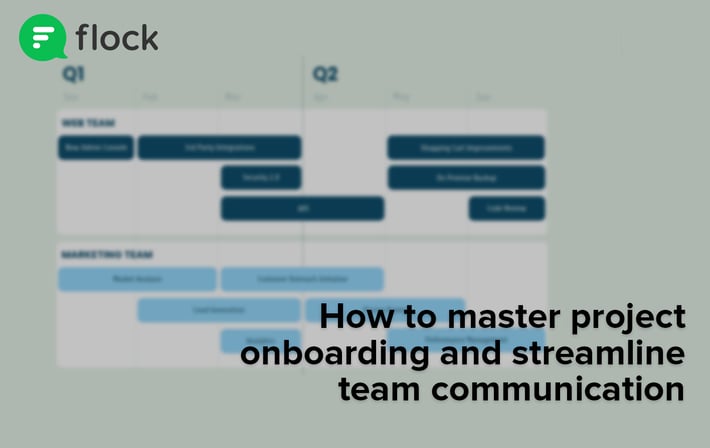 You’re probably familiar with what employee engagement is by now, but how ready are you to enact an employee engagement initiative?
You’re probably familiar with what employee engagement is by now, but how ready are you to enact an employee engagement initiative?
Improving engagement in your organization, just like building culture, isn’t a simple fix like implementing Happy Hour Fridays… although those do help a bit. Your management and HR teams need to work together to build a comprehensive plan to keep employees happy, motivated, productive, and healthy.
Here are some steps to building out your business’s employee engagement plan:
Focus on your company mission statement
What’s your company mission statement? “Borrow” core values and goals for your employee engagement plan directly from your mission statement.
Let’s look at part of our mission statement at Flock: With a healthy body and mind, you can achieve anything.
We have clear initiatives toward our goal of enabling physical and mental wellness for all our employees. To fulfill that, we offered a range of wellness initiatives at our offices in Mumbai and Bengaluru, including an in-house gym and a doctor-on-call facility, as well as short-term counseling to deal with work, personal, or legal issues. Those initiatives worked toward our mission of securing employees’ holistic health.
Of course, the pandemic led to some adaptations to our wellness plan… read more to find out how we adjusted.
Building direct goals from your mission statement lets employees know that their values align with those of the company, and encourages them to take part in said goals.
Measure your current employee engagement levels
It goes without saying, but your engagement plan means little if you can’t measure its success. Start off by getting feedback from your employees. Ask them about their general happiness and productivity levels. Take a look at the hours they’re working and see what their work-life balance looks like. Review your benefits and culture initiatives with them and see if they feel satisfied and invested.
It doesn’t have to be a long, drawn-out conversation, especially if you have too many employees to sit down for hours-long chats. In fact, effective feedback and insights can be delivered entirely remotely if you choose to make use of intelligent idea management software. Weave this feedback process into performance reviews and exit interviews, and encourage employees to submit feedback to HR on a regular basis. There are plenty of tools and systems that can help you gauge engagement—the occasional pulse survey via a Google Form, weekly check-ins on 15five, the Gallup Q12 Employee Engagement Survey, and employee NPS (or eNPS), to name a few.
Now, take what you’ve learned from all the feedback you’ve received: maybe your employees appreciate that you have an in-house gym but they don’t have time to work out at the office and take care of their kids at home. Address those gaps to ensure your engagement plan fits everyone’s needs.
Read our guide to employee engagement for more information on measuring engagement in your organization.
Build your employee engagement plan
There are countless initiatives your organization can take to keep employees engaged. Remember those Happy Hour Fridays I mentioned? Events like those are great for building relationships and helping employees let their hair down around each other. Bringing your team together with events like a trivia quiz or game night also confers solidarity and appreciation for your company.
Perhaps your employees are happy with each other but want more opportunities for professional development. You can offer in-house seminars, skill-sharing opportunities, and even tuition reimbursement to encourage that growth and invest in a developing employee.
Or maybe you’re looking for ways to keep your employees healthy. And that probably changed in light of the pandemic.
“Unprecedented circumstances call for innovative thinking and focused efforts towards helping all of us stay healthy and productive,” explains Flock’s Chief Operating Officer Abhishek Sen.
Together with our HR, facilities, finance, and IT teams, Abhishek started brainstorming a plan for state-of-the-art healthcare support for all our employees who adjusted to working remotely—and even to working in other countries, in some cases. Our healthcare initiatives easily translated to telehealth, virtual workouts, and 1:1 virtual counseling sessions, but they didn’t include provisions for the novel coronavirus.
To do this, we built a simple three-pronged initiative, dubbed CARE (Covid Assistance and Risk Elimination):
- We wanted this initiative to be digital, so that it’s remote and easily accessible to all our employees.
- We wanted the support to be comprehensive. Not just medical coverage or physician consultations—it would have to cover consultation, medication, financial support, and even provide an improved leave policy for affected employees.
- The support needed to cover both the employee and, in some cases, their family through this initiative because we’re all staying at home. If one gets infected, so do others at home, and then care is required not just for the employee but for family members as well.
Our CARE plan offers our employees a work from home setup of a desk and chair, reimbursements for broadband internet plans and IT subscriptions, and an emergency salary advance of up to three months. Newly introduced medical benefits include family-wide telehealth development company and additional leaves to recover from Covid. We also set up a special CARE helpline for any employee concerns or needs not already addressed by the plan.
This plan is still in its early stages as of November 2020, but the CARE initiative has already helped several of our employees and their families impacted by the pandemic. And we’re continuously taking feedback so we can improve and ensure state-of-the-art employee welfare in the organization going forward.
Launch employee engagement initiatives
Before launching your initiatives, let’s review the steps you need to take to develop an effective employee engagement plan:
- Dissect your company values
- Measure your current engagement
- Build a plan around employee feedback
Run this plan by the managers of each of your teams. You want to make sure it is comprehensive and accessible for all employees—especially if most are currently working from home. Ensure that your company can cover the initiative both financially and logistically, and address any barriers before they happen. Then, watch as your employees engage and make magic happen!








